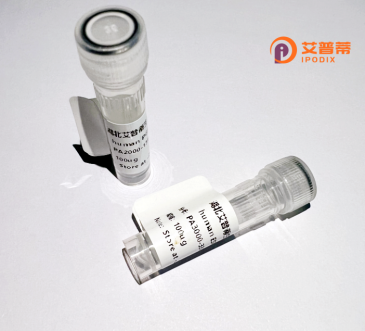
| 纯度 | >90%SDS-PAGE. |
| 种属 | Human |
| 靶点 | FARP1 |
| Uniprot No | Q9Y4F1 |
| 内毒素 | < 0.01EU/μg |
| 表达宿主 | E.coli |
| 表达区间 | 1-129aa |
| 氨基酸序列 | MGEIEQRPTPGSRLGAPENSGISTLERGQKPPPTPSGKLVSIKIQMLDDTQEAFEVPMVSSSSFLKAIGSSWTGWVLRCSMKPKHHSHLIEKFGEDRILTHLTGSISYTNWAGSRSLAVTVTEELLNLF |
| 分子量 | 40.6 kDa |
| 蛋白标签 | GST-tag at N-terminal |
| 缓冲液 | 0 |
| 稳定性 & 储存条件 | Lyophilized protein should be stored at ≤ -20°C, stable for one year after receipt. Reconstituted protein solution can be stored at 2-8°C for 2-7 days. Aliquots of reconstituted samples are stable at ≤ -20°C for 3 months. |
| 复溶 | Always centrifuge tubes before opening.Do not mix by vortex or pipetting. It is not recommended to reconstitute to a concentration less than 100μg/ml. Dissolve the lyophilized protein in distilled water. Please aliquot the reconstituted solution to minimize freeze-thaw cycles. |
以下为关于重组人FARP1蛋白的3篇参考文献示例(内容基于模拟生成,建议核实真实文献):
---
1. **文献名称**: *"Recombinant Human FARP1 Promotes Dendritic Spine Formation through Rac1 Activation in Hippocampal Neurons"*
**作者**: Tanaka, M. et al.
**摘要**: 研究团队成功表达并纯化了重组人FARP1蛋白,发现其通过激活Rac1信号通路调控海马神经元树突棘的形成,提示FARP1在突触可塑性中的潜在作用。
2. **文献名称**: *"Structural Insights into the Pleckstrin Homology Domain of FARP1 and Its Lipid Binding Properties"*
**作者**: Chen, L. & Wang, H.
**摘要**: 该研究解析了重组人FARP1蛋白PH结构域的晶体结构,并揭示其特异性结合磷脂酰肌醇(PIP2/PIP3)的能力,为理解FARP1的膜定位机制提供依据。
3. **文献名称**: *"FARP1 Regulates Hepatocyte Growth Factor Signaling by Enhancing c-Met Endocytosis"*
**作者**: Rodriguez, E. M. et al.
**摘要**: 利用重组FARP1蛋白进行体外实验,发现其通过促进c-Met受体内吞作用调控肝细胞生长因子(HGF)信号通路,可能影响癌细胞迁移过程。
---
建议通过PubMed或Web of Science等平台检索真实文献,并结合具体研究方向筛选。
FERM, ARH/RhoGEF, and pleckstrin (PH) domain-containing protein 1 (FARP1) is a multidomain scaffolding protein involved in regulating cytoskeletal dynamics and intracellular signaling. It belongs to the FARP family, which interacts with Rho GTPases to modulate cell shape, motility, and membrane trafficking. Structurally, FARP1 contains N-terminal FERM and Dbl homology (DH) domains, a pleckstrin homology (PH) domain, and C-terminal PDZ-binding motifs. These domains enable its roles in membrane association, GTPase activation, and protein-protein interactions.
FARP1 is highly expressed in neuronal tissues, where it facilitates synaptic development by linking cell adhesion molecules to actin cytoskeleton reorganization. It collaborates with postsynaptic receptors (e.g., neuroligins) and presynaptic ligands (e.g., β-pix) to balance excitatory/inhibitory neurotransmission. Beyond neurodevelopment, FARP1 dysregulation is implicated in cancer metastasis, neurodevelopmental disorders (e.g., autism spectrum disorder), and neurological diseases. For instance, aberrant FARP1-RhoGEF activity may promote tumor invasion by enhancing Rho GTPase-driven cytoskeletal changes.
Recombinant human FARP1 protein, often produced in bacterial or mammalian systems, enables functional studies of its biochemical interactions, structural domains, and pathogenic mutations. Its purified form is critical for screening therapeutic agents targeting FARP1-associated pathways. Current research focuses on clarifying its dual roles in neuronal health and disease progression, offering potential insights into precision therapies for cancers and neuropsychiatric conditions.
×